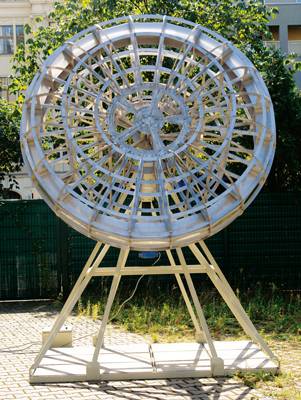
For her first solo exhibition at Johann König, Berlin, Alicja Kwade will be showing an installation as well as a new video work. Eleven steel plates, lacquered in shiny black and varying in size, describe a sine curve’s form in diverse frequencies. The plates, each having a different form, build a resonance mirror for the sonorous crackling and rustling coming from the speakers positioned in front of them. The speakers in turn, are connected with cables to the lighting tubes under the roof, whose sound will be played-back over a magnetic cartridge.
Through acoustic amplification, Kwade makes electromagnetic waves audible as background noise while at the same time visualizing the complete physical foundation of light and sonic waves by means of the steel plates. The form of the wave distorts its own mirror image as it doubles itself at some points, while disappearing at others. Similarly, on an acoustic level, depending on the position, the noise is either reflected or overlaps itself, causing it to be louder or quieter as one passes by.
Kwade works with the basic forces of physics which make up our world. She goes back to the origin of the universe, where matter, space and time emerged from a singularity at its zero point. She seeks to make the unpresentable graspable and finds a sensory correspondence for abstract phenomena, which only find their fulfillment in theory and are perceived by us only in a very small fraction as light and sound for example.
In her new video work, the artist also questions our perception of reality. The looped film appears to show a meteorite, lightly floating through outer space, which moves through the image as it slowly turns from right to left. Actually, it is only a common pebble’s flight, which was recorded with a high speed camera. Once again, the limits of our perceptual space come to light as Alicja Kwade, from an ironic standpoint, pushes open the door to those worlds which lay hidden behind.
With an installation outside of the gallery space, Kwade further delves into the parallel worlds of our perception. Two silver-colored Nissan Micras park in front of the entrance. One vehicle is the mirror image of the other. Not only is the steering wheel mirrored, but also the dent on the fender can be found identically on the other side of the second vehicle. Even the randomly scattered everyday items in the vehicle find their correspondence. The testimony of an accident is doubled in a mirror image made reality.
Alicja Kwade (born 1979 in Katowice, Poland) lives and works in Berlin, where she studied at the Universität der Künste until 2005. In 2008 she won the Piepenbrock Prize for Sculpture, which was conjoined with a large solo exhibition at the Hamburger Bahnhof ˆ Museum for Contemporary Art – Berlin.
translation: Verónica Lehner
backyardoutdoorsculptureseries#1:
ANDREAS ZYBACH
Rotating Space
opening reception: September 12, 6 – 9 p.m.
We are pleased to announce the launch of our new outdoor sculpture project backyardoutdoorsculptureseries#1 which opens simultaneously to Alicja Kwade’s solo show at Johann König, Berlin. The series will start with rotating space by Andreas Zybach and will be shown in the adjecend backyard of the gallery.
The project Rotating Space is based on a concept which NASA used for planning the construction of space stations well into the sixties. Wernher von Braun and other space scientists attempted to create a ring-shaped architecture in which the weightlessness of space would be replaced by a rotational force which would create its own “gravity” and thereby the impression of earth-like conditions inside.
A comparable principle in terms of constructing a controllable environment was realized 2004 at the Botanical Gardens in Munich and its greenhouses and is now on display in its second version at Johann König, Berlin. The exhibit attempts to bring the two approaches together. Soil, water and seeds are held in the scale model of the space station by means of the rotation effect already described. The growth process is facilitated by the object’s constant movement. The project ends when the model comes to a standstill.